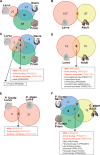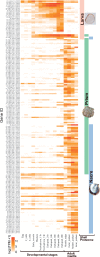Dual Gene Repertoires for Larval and Adult Shells Reveal Molecules Essential for Molluscan Shell Formation
- PMID: 30169718
- PMCID: PMC6231486
- DOI: 10.1093/molbev/msy172
Dual Gene Repertoires for Larval and Adult Shells Reveal Molecules Essential for Molluscan Shell Formation
Abstract
Molluscan shells, mainly composed of calcium carbonate, also contain organic components such as proteins and polysaccharides. Shell organic matrices construct frameworks of shell structures and regulate crystallization processes during shell formation. To date, a number of shell matrix proteins (SMPs) have been identified, and their functions in shell formation have been studied. However, previous studies focused only on SMPs extracted from adult shells, secreted after metamorphosis. Using proteomic analyses combined with genomic and transcriptomic analyses, we have identified 31 SMPs from larval shells of the pearl oyster, Pinctada fucata, and 111 from the Pacific oyster, Crassostrea gigas. Larval SMPs are almost entirely different from those of adults in both species. RNA-seq data also confirm that gene expression profiles for larval and adult shell formation are nearly completely different. Therefore, bivalves have two repertoires of SMP genes to construct larval and adult shells. Despite considerable differences in larval and adult SMPs, some functional domains are shared by both SMP repertoires. Conserved domains include von Willebrand factor type A (VWA), chitin-binding (CB), carbonic anhydrase (CA), and acidic domains. These conserved domains are thought to play crucial roles in shell formation. Furthermore, a comprehensive survey of animal genomes revealed that the CA and VWA-CB domain-containing protein families expanded in molluscs after their separation from other Lophotrochozoan linages such as the Brachiopoda. After gene expansion, some family members were co-opted for molluscan SMPs that may have triggered to develop mineralized shells from ancestral, nonmineralized chitinous exoskeletons.
Figures




Similar articles
-
Phylogenetic comparisons reveal mosaic histories of larval and adult shell matrix protein deployment in pteriomorph bivalves.Sci Rep. 2020 Dec 17;10(1):22140. doi: 10.1038/s41598-020-79330-x. Sci Rep. 2020. PMID: 33335265 Free PMC article.
-
Identification of conserved proteins from diverse shell matrix proteome in Crassostrea gigas: characterization of genetic bases regulating shell formation.Sci Rep. 2017 Apr 4;7:45754. doi: 10.1038/srep45754. Sci Rep. 2017. PMID: 28374770 Free PMC article.
-
Microarray: a global analysis of biomineralization-related gene expression profiles during larval development in the pearl oyster, Pinctada fucata.BMC Genomics. 2015 Apr 19;16(1):325. doi: 10.1186/s12864-015-1524-2. BMC Genomics. 2015. PMID: 25927556 Free PMC article.
-
The evolution of mollusc shells.Wiley Interdiscip Rev Dev Biol. 2018 May;7(3):e313. doi: 10.1002/wdev.313. Epub 2018 Feb 22. Wiley Interdiscip Rev Dev Biol. 2018. PMID: 29470863 Review.
-
Deciphering mollusc shell production: the roles of genetic mechanisms through to ecology, aquaculture and biomimetics.Biol Rev Camb Philos Soc. 2020 Dec;95(6):1812-1837. doi: 10.1111/brv.12640. Epub 2020 Jul 31. Biol Rev Camb Philos Soc. 2020. PMID: 32737956 Review.
Cited by
-
Functional shell matrix proteins tentatively identified by asymmetric snail shell morphology.Sci Rep. 2020 Jun 17;10(1):9768. doi: 10.1038/s41598-020-66021-w. Sci Rep. 2020. PMID: 32555253 Free PMC article.
-
Transcriptomic analysis of shell repair and biomineralization in the blue mussel, Mytilus edulis.BMC Genomics. 2021 Jun 10;22(1):437. doi: 10.1186/s12864-021-07751-7. BMC Genomics. 2021. PMID: 34112105 Free PMC article.
-
Expression of calcification-related ion transporters during blue mussel larval development.Ecol Evol. 2019 May 29;9(12):7157-7172. doi: 10.1002/ece3.5287. eCollection 2019 Jun. Ecol Evol. 2019. PMID: 31380040 Free PMC article.
-
Multi-omic insights into the formation and evolution of a novel shell microstructure in oysters.BMC Biol. 2023 Sep 29;21(1):204. doi: 10.1186/s12915-023-01706-y. BMC Biol. 2023. PMID: 37775818 Free PMC article.
-
Diversification of von Willebrand Factor A and Chitin-Binding Domains in Pif/BMSPs Among Mollusks.J Mol Evol. 2024 Aug;92(4):415-431. doi: 10.1007/s00239-024-10180-1. Epub 2024 Jun 12. J Mol Evol. 2024. PMID: 38864871 Free PMC article.
References
-
- Addadi L, Joester D, Nudelman F, Weiner S.. 2006. Mollusk shell formation: a source of new concepts for understanding biomineralization processes. Chem Eur J. 12(4): 980–987. - PubMed
-
- Alagarswami K, Dharmaraj S, Velayudhan TS, Chellam A, Victor ACC, Gandhi AD.. 1983. Larval rearing and production of spat of pearl oyster Pinctada fucata (Gould). Aquaculture 34(3–4): 287–301.
Publication types
MeSH terms
Substances
LinkOut - more resources
Full Text Sources
Other Literature Sources

